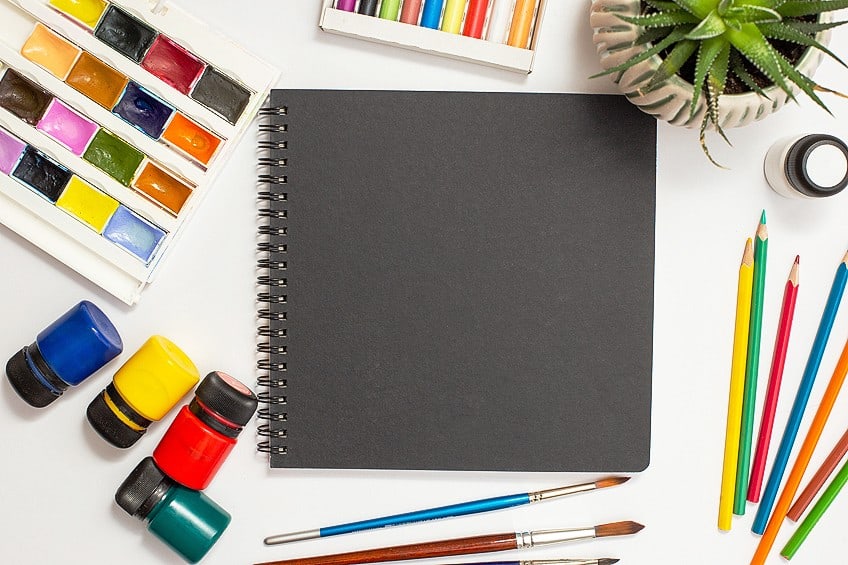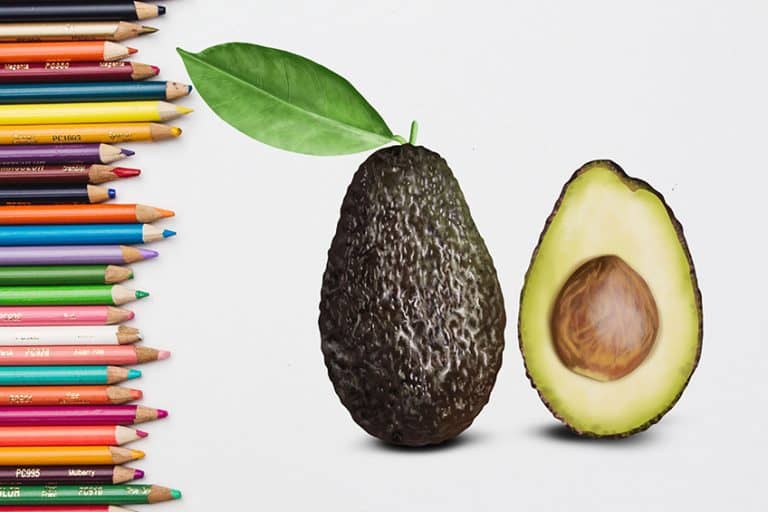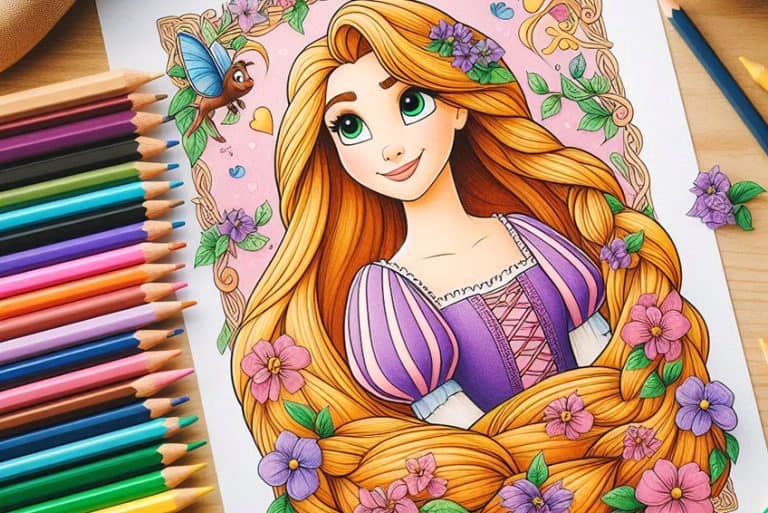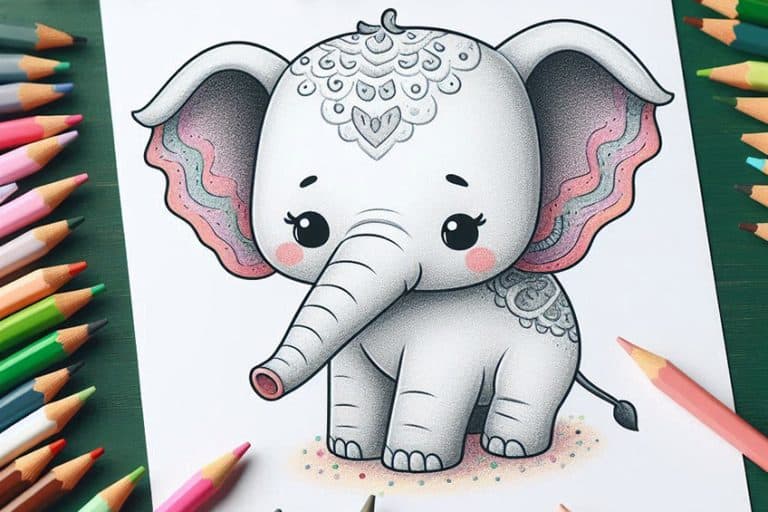Sketchbook Ideas – Things to Draw in Your Sketchbook
You may be one of those people who loves to draw, or you are just a beginner wanting to start drawing. You need some cool sketchbook ideas to get your creative juices flowing. In this article, we will be giving you some very detailed information on what to choose when drawing in your sketchbook. Most of these sketchbook ideas are practical and easy to draw. There is something for everybody, from beginners to seasoned artists. So, get inspired and let’s start drawing!
How to Use a Sketchbook?
A sketchbook is a very personal item, and each artist’s sketchbook is unique. When it comes to things to draw in your sketchbook, you might want to only use one medium throughout, or you may want to spend more time and thought on your drawings. You might also want to use your sketchbook for warming up exercises or use it just for doodling whatever comes into your mind. Your sketchbook needs to be a place where you can learn to improve your skills. The more you draw, the better you become, so do not be too concerned about messing it up as you do not have to show it to anybody but yourself. You do not have to make each sketchbook page a masterpiece when you start to sketch. As you progress with your drawing skills, you will be able to see improvement in your artwork.
If you focus on regular drawing practice, your art will improve very quickly, and you will soon complete many sketchbooks over the years. Remember to keep your sketchbooks, so you can track your drawing progress.
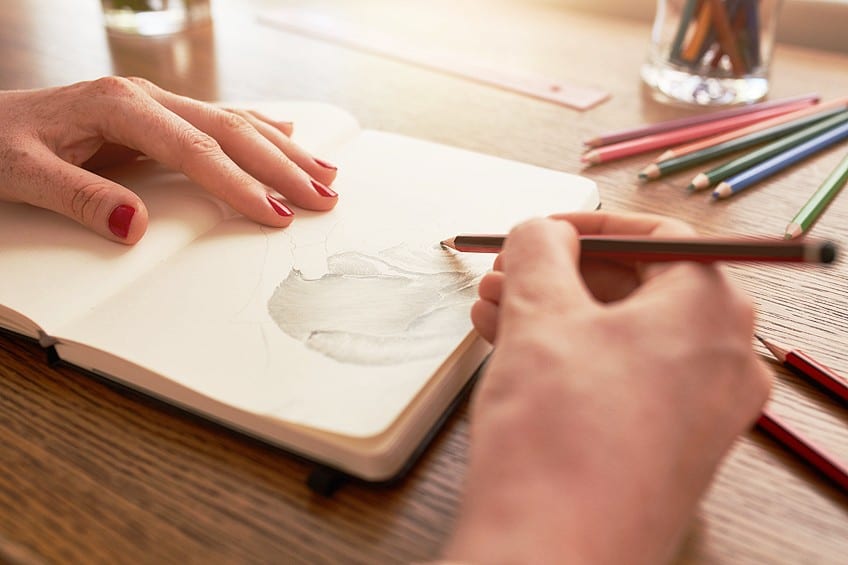
Tips on How to Start Using Your Sketchbook
There is no special rule or way to start using your sketchbook, and each sketchbook is unique and belongs to you. However, it may be helpful if we can give you some guidelines and tips on how to start using your sketchbook.
Start Simple
An easy way for you to start is to take a simple idea and on the first blank page, start drawing simple shapes, like stick men, or a house, or some geometrical shapes like squares or triangles. You may want to start by sketching your favorite characters from a movie or a book, whatever way you want to start is a good place. Experiment a little until you find the right medium that suits you. Try drawing or sketching using a pencil or pen first and see what you are comfortable using.
If you want to try painting, then a good start is watercolors, where you will be able to use different techniques and find the one that suits you.
Copy What You See
Another way is to take the work of famous artists or painters and try to copy some of it. You can also just go outside for a walk and start sketching nature as you see it. It might amaze you to see what you can achieve by just taking the time to begin drawing. If you are still uncertain about where and how to start using your sketchbook, enroll in an art class and try some drawing lessons before you start drawing in your sketchbook. This may be the start you need to get your imagination going.

Purchase the Right Sketchbook for Your Artwork
When buying your sketchbook, you need to select the right one that will suit your drawing needs or skills. If you choose to use watercolors, then buy a sketchbook with heavy paper that can hold the wet media and not buckle and warp.
If you choose to draw with ink or a pen, then choose a sketchbook that has smooth paper and fine texture.
Choosing a Size That Suits Your Needs
Choosing your sketchbook size is important as this determines the number of pages it contains. So, if you are going to sketch daily, then you need to buy a larger sketchbook that has more pages. If you intend to take your sketchbook with you on a field trip, then you need to consider the size that will fit into your bag. The size of your hands will also play a part in the size of the sketchbook you want, for small hands then a smaller sketchbook is preferable, or for larger hands, a larger sketchbook is recommended. The size of the sketchbook is not too important if you just want to use it at home to practice your drawing skills or just to doodle in.
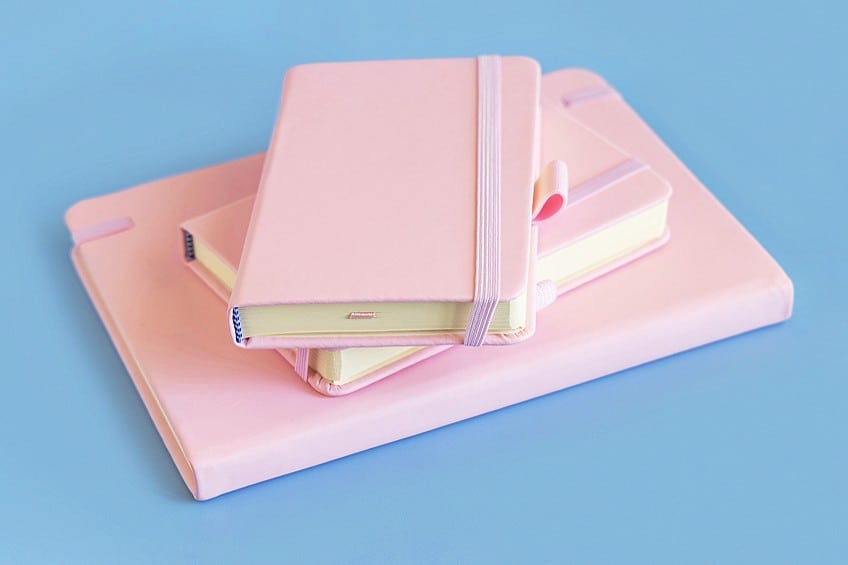
Choosing the Paper
Choosing the right type of paper for your sketchbook is very important as it can make a huge difference in your experience with your sketchbook. The paper of some sketchbooks is excellent for sketching but not writing, while others are perfect for doodling but not for sketching. The first thing you need to consider when choosing the right paper for your sketchbook is what type of artwork you intend to create.
When drawing using pencils or pens, smooth paper is ideal, but for watercolors or acrylics, rough textured paper is necessary.
Consider the Drawing Methods
Sketchbooks with different types of paper will enable you to improve your drawing and sketching skills. The different paper textures will help you to use different mediums like pencil, watercolors, and charcoal, but avoid mixing oil and acrylic mediums that may take a long time to dry or are too thick for the paper. The different textures of the paper surfaces will teach you how to adapt your drawing and sketching style. Working with charcoal or pencils on rough paper makes you draw thicker and heavier lines, and drawing on smoother paper makes you draw lines that are thinner and finer.
Consider Price and Quality
When choosing the right sketchbook, quality, and price play an important role. You need to make sure that the sketchbook you choose is durable, but not too expensive to replace. However, when you are using your sketchbook for professional purposes, you need to make sure the quality is the best to enable you to preserve your sketches for a very long time.
Positioning of Pages
When using your sketchbook, you do not want the pages to curl up and interfere with your sketching. Some sketchbooks are glue bound and the pages are not able to lay flat, which can hinder your drawing. A spiral-bound sketchbook is a better option, allowing the pages to fold back easily and lay flat.
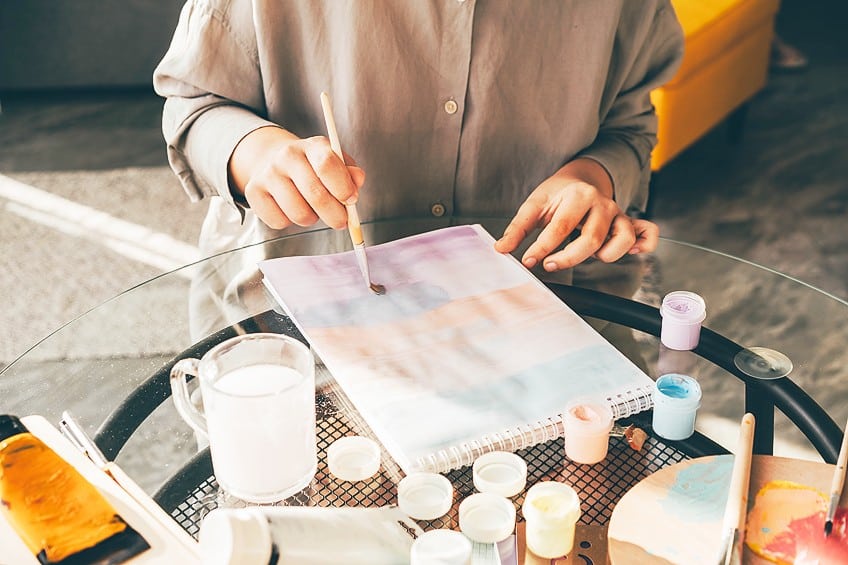
Consider Buying More Than One Sketchbook Each Time
If you only buy one sketchbook and halfway through you feel like using a different medium, or if you are busy and do not have enough time to wait for the ink or paint to dry, you need to have more than one sketchbook. You should be able to change from one to the other any time you feel like it.
Buy Different Types of Sketchbooks
Some people prefer small compact sketchbooks that are easy to just pop into your purse and take wherever you go. Others prefer larger and thicker sketchbooks with more pages and a lot more space to fill.
You will soon discover the right sketchbooks that suit your needs and style best.
Sketchbook Ideas for Beginners
Drawing is an art and for some, it comes naturally, but it is also a craft that can be learned and mastered by anyone. However, like everything else, you need to improve your artistic skills, and you can do this through regular practice. You need to practice using different drawing exercises that will enable you to improve your artistic skills. We are going to help you get started by giving you some basic and easy drawing exercises that will help to improve your drawing skills.
Doodling Exercises
Doodling means “to draw, scribble idly or to sketch”, and is an activity that many people do unknowingly, especially when they are bored or unable to pay attention. You just start to scribble different patterns, shapes, or lines on a piece of paper, and it can be very useful when you do it creatively. Doodling exercises can help to reduce stress and improve your memory, and the best thing about it is that it can be done by anybody irrespective of your artistic background. You can begin with simple figures and then move on to more complex ones. You do not have to have everything you draw to be perfect; it is just a process of getting your thoughts and ideas onto paper.
Basic Shape Drawing Exercise
Start to draw some basic shapes and do not be concerned about any details, just focus on various shapes. For example, a circular shape, a flower can be a circular shape, and the stem is two parallel lines. An ice cream cone is an upside-down triangle and the ice cream on the top is a circular shape. Draw lines of different thicknesses with pens of different sizes, which means you need to have a couple of different-sized pens to create lines of varying thicknesses.
Start with drawing the outer lines with a thick pen and then finer and smaller lines for the details.
Drawing from Observation
All drawing is an art of observation and is the best way for you to understand all the different shapes in the world around you. Learn how to draw trees, flowers, and people, or learn how to transform crossed and parallel lines into shadows, textures, and light in your sketchbook.
Sketching Portraits
When you first start to sketch a portrait, it may feel a little intimidating. It takes a bit of practice as the human face is a lot different from landscapes and architecture. Measurement and accuracy are very important, as being a few millimeters out can make the entire drawing look wrong. Begin with the eyes, next sketch the nose and shape the head. Then you can shape the hairline and the hair. Lastly, you can begin to draw contrasts with shadow values, shading the left side and hair and leaving the right side untouched. Create a light line on the nose and your portrait is complete.
Create a Mood Board
Mood boards are everywhere, but especially on social media platforms, and they consist of samples, images, colors, textures, and texts. The aim is to convey a mood or idea about a particular topic. They are visual representations, informing the viewer of the vibe or feeling of a topic or concept.
They can be randomly chosen or based on a topic, they can be physical or digital, and they can also be only text-based.
Sketchbook Ideas for Intermediate Artists
You may be an art student, or you have been practicing sketching for a long time, and you feel the need for sketching is past. Remember, your art sketchbook is a place where you try your ideas out to see if they will work, it keeps you organized and on track, and it is a tool that will help to improve your artistic skills. So, if you feel you are past the beginner’s stage and you want something more challenging, then let us see what other sketchbook drawing ideas there are. Things to draw in art class, that are geared toward the intermediate artist.
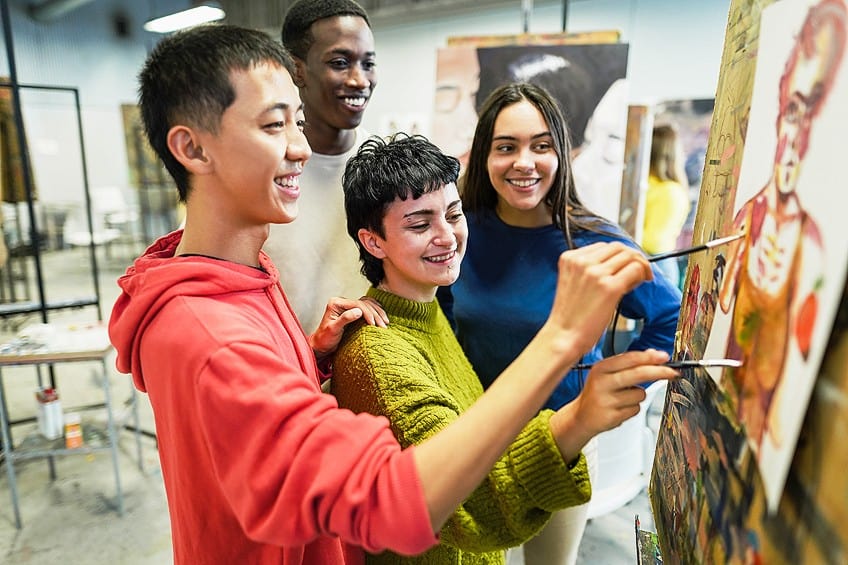
Sketching With Different Mediums
Different mediums have been used by artists for centuries, enabling them to create masterpieces of art. The different drawing, sketching, and painting styles appear to have the most art mediums that are available.
We will show you the different art mediums that are available, and then you can choose the one medium that will be best for your project.
Oil Paint
Over the centuries tempera was the art medium used until oil paints arrived, which made oil paints the traditional medium for artists. It was popular amongst artists due to its slow drying time, which gave the artist time to make any changes to their paintings before the paint dried. It also allowed you to add more layers of paint, techniques still used today.
Acrylic Paint
With the arrival of acrylic paint, it soon became the most popular medium for artists due to its quick drying time, and water-resistant quality. The advantage of using acrylic paint is that you can add depth and textures by applying more layers of paint, and you do not have to wait for a long time to complete the process.
The paint also allows you to add more water so you can create a certain matte look for your artwork.
Watercolors
Watercolors are very popular amongst artists because there are a very large number of colors to choose from, enabling you to create amazing art pieces. Due to the luminosity of its pigments, it is also ideal for landscapes. However, it is not a very easy medium to work with if you are a beginner, and it will take time to master its abilities. One big disadvantage with watercolors is that once you have applied them to your canvas or paper, there is not much that you can do to change the result.
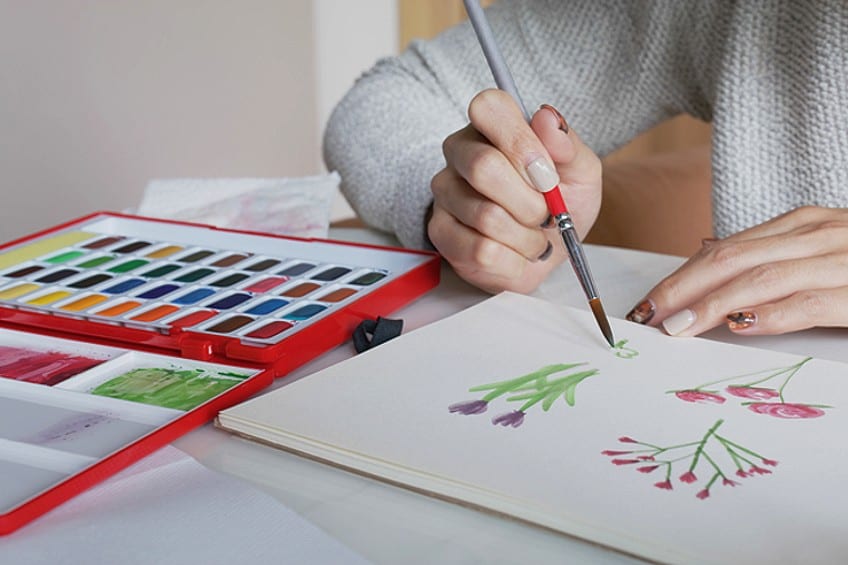
Charcoal
Fire has played a role in human development for centuries, which made charcoal readily available as an art medium. Today we can purchase charcoal sticks, but many artists do not use them as they are too easily erased. So, if you plan to use a charcoal stick for your artwork, apply some form of fixture that will extend the life of your art piece.
Pastels
Pastels are very similar to oil paints as they are produced by mixing pigments with a binding material. There are a variety of pastels you can work with, depending on the technique you want to apply. Hard pastels are ideal for outlines and composition sketching, while soft pastels are used for blending.
Chalk
Chalk is another one of those art mediums that have been used by artists over the centuries. Materials like ochre, black stone, and limestone were used to create different colors. Today, you can purchase chalk in several different colors, and it is an ideal medium to use for sketching.

Graphite Pencils
Graphite pencils are great mediums for artwork, like creating sketches, applying shading to an art piece, or outlining compositions. )t is an ideal medium to use for beginners as it can easily be erased, allowing you to edit your sketch and fix the mistakes until you are satisfied with the result.
Colored Pencils
Colored pencils are art mediums that are used often by art students as they are a perfect art medium to use to improve your skills. You can use them to create simple sketches or drawings, or they can also be used to create more detailed artworks that can almost look photorealistic.
Ink and Pens
Ink is a great medium to use to create solid outlines and can also be used to create more intricate graphic art pieces, as well as text-based art forms like calligraphy. Depending on what form of art you want to use, pens can come in various forms, like fountain pens, graphic pens, and drafting pens. However, you need to use pens with caution as the ink is permanent once applied and cannot be erased.

Still Life Drawing
Sketching still-life objects is the perfect way to learn some important drawing skills like shading, composition, foundations, and reflections, and enhance your drawing skills. Try a variety of different objects, which will help you gain experience in different areas.
Also, because it is a still-life object, the level of difficulty is entirely up to you.
Landscape Drawing
You can draw scenes of mountains, beaches, and forests, which will help you to deal with issues like light, texture, proportion, and shadows. All these issues are cornerstones in developing strong artistic practice. You can also enjoy it, as you will be out there seeing the sights and hearing the sounds.
Perspective Drawing
Perspective drawing gives the objects a three-dimensional effect and creates an illusion of depth by making the objects appear more realistic, using angled lines and making them appear like horizontal or vertical lines.
There are two types of perspective drawing, linear and atmospheric.
Linear Perspective Drawing
This perspective allows objects that are further away to appear smaller than the same objects that are nearer. This is achieved when the parallel lines come together or merge, in the distance where they reach their vanishing point.

Atmospheric Perspective Drawing
Atmospheric perspective drawing depends on entirely different values and can also be referred to as aerial perspective. It is best explained when a landscape scene is viewed from a distance, and the mountains nearest show a great amount of detail of grass and trees, but the mountains in the distance show very little detail.
Urban Drawing
Urban sketching is sketching from location, in other words, the material is not taken from a photo, or done in a house or studio but is real life. This type of drawing or sketching focuses more on street scenes, and architecture, and can even include people in shops or cafés. The benefit of urban sketching is that the artist can personally relate to the situation as they were there and have a story to tell.
This kind of drawing is also known as visual reporting or storytelling.
Sketchbook Drawing for Advanced Artists
Advanced drawing is using some drawing techniques that will go beyond the basic artistic skills, taking you to the next level and helping you to refine your sketching into real polished art. One of the best advantages of sketchbook drawing is your ideas, they are personal and limited only to your imagination. You may be a professional artist, but creative blocks are very real, and at times, all you need is a little inspiration for some new ideas.
Creative Lettering
Creative lettering or hand-lettering as it is also referred to, has often been confused with calligraphy, but there is a difference. Calligraphy uses prefabricated or designed letters and is written with a single pass; this is what creates the written art. Creative lettering is letters that come together to form a single and unified piece, and if you took each letter separately and created your alphabet, the result would be a complete jumble. You can use creative lettering to add extra finesse to any invitations, postcards, cards, or any other form of templates you design and want to customize.
Experimental Mark Making
Mark-making is the action by the artist to produce any type of mark on any surface, like canvas, paper, textiles, floors, or walls. The tool you use to make the marks can be a brush, palette knife, stick, toothbrush, cotton bud, charcoal, pen, feathers, or pencil experiment for yourself and see what you can produce. When your tool touches the surface it leaves a mark, which can be in the form of a dot, shape, line, pattern, or texture.
You can use the marks you make as building blocks for your future artwork, which can represent who you are and what you wish to express.
Mixed Media Drawing
Mixed media art is a combination of using two or more mediums in one art piece. Instead of just creating a watercolor painting, try mixing it with acrylic or oil paint. Combining paint with other materials like paper or fabric is also regarded as mixed media art, or mix your media techniques and combine decoupage, scrapbooking, sketchbooks, or decorating cards as a form of mixed media art. Mixed media art can open a new world of possibilities for you to explore using new styles, and materials. It is a way to add more dimension to your art pieces allowing it to expand the idea of what art is. There is no right way and no rules; you just get started and use your creative imagination.

Collaborative Drawing
Collaborative drawing is where you get to draw together with your friends, or other artists, in real-time or even over the Internet. You can create a new canvas and then share it with others and begin to draw together. This is an art form that is fun to do and encourages people to work together to create something beautiful.
It can also be used for brainstorming when working together with a group on a particular project.
Drawing from Imagination
Drawing from imagination may sound like a very difficult thing to do, as you are not able to see the image you want to draw. It is drawing from your long-term memory, putting bits of your memory together, and creating something new. Imagine you want to draw a mermaid, you picture, in your mind, a woman that has a fishtail with scales and long hair. This most probably comes from a picture you saw at some time or other, and now all you need to do is use those elements and make the thought a reality.

Sketchbook Ideas for Specific Themes
Many times, you may find yourself not knowing what to draw, and drawing a theme may be just the answer you are looking for. Try to organize your sketchbooks into different themes, allowing you to draw things that you may not have thought of and providing you with more mental space to continue drawing. Here are some themes that we think you will enjoy.
Travel Sketchbook
Keeping a sketchbook while on your travels is an ideal way to document all your adventures in one place. You can track all the places you visited, all the different people you met, and all the experiences you had on your travels. It is one of the most inspiring things that you can do, providing you with a constant visual reminder, as well as being a creative outlet for exploring new techniques and ideas. Whether you are waiting in a queue, sitting in the park, or gazing at a monument, it will always be an asset for you. All you need is an easy-to-carry, pocket-sized sketchbook with good-quality paper and a mechanical pencil that always has enough lead and does not need to be sharpened. Also, you can try working with a refillable fountain pen.

Nature Sketchbook
Nature is such a vast subject; you have landscapes, birds, animals, flowers, and trees. The scope is endless, which means there is a lot of inspiration for you to include in your nature sketchbook. You do not have to go far as you can begin in your own garden, where you can find birds, trees, flowers, grass and much more. However, to make it more fun and interesting, take a trip to the woods, forest, or even the park where you will find enough inspiration to start your nature sketching.
Most nature sketching themes can be grouped into three categories, landscapes, flora and fauna, and birds, and you may want to also include other types of sketching in the nature sketchbook that you regard as nature sketches.
Food and Drink Sketchbook
Sketching food and drink does not have to be complicated or cost you a lot of money. You can start in your own kitchen by looking inside your refrigerator. Choose one item like a ripe tomato, and then look at and handle it using all your senses, before you start to sketch. Take note of the texture, the colors, and the smell, and if there are any noticeable markings. Sketch it from different angles, even slice it up and sketch what each piece looks like. You can try the same process by sketching a bowl of fruit, a cup of coffee, or a glass of wine, there are endless possibilities right there in your kitchen.
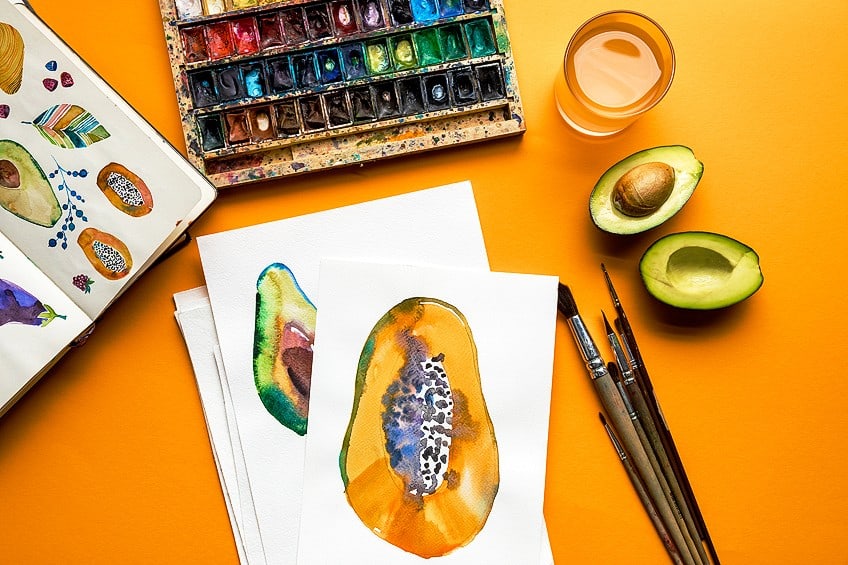
To make it more of a challenge, the next time you go to a restaurant, take your sketchbook with you and begin to sketch what you see on your plate, or what you are drinking. You can take it a step further and sketch the people and the waiters carrying the food. These are also great ideas and things to draw in art class.
Fashion Sketchbook
Fashion designers usually start by making a croquis (a quick sketch of a human body that can serve as a template to fit some type of clothing item) this sketch does not have to have hands, feet, or a face. They can then use it to drape any form of clothing that they want to design, but this does not have to only be for designers, you can do the same for your fashion sketchbook. When going shopping, you need to take your fashion sketchbook with you and when you pass by a clothing shop take out your book and start to sketch what you see. Look around at all the people you observe and sit down on a bench and begin to start sketching what the people you see are wearing.

Architecture Sketchbook
Architecture sketching is merely artists’ sketches of buildings or some elements of the buildings, and they do not have to include scales and keys like an architect’s drawings do. Architecture sketches are personal records, memories, and observations of journeys and experiences that you have been through and trips to various destinations you have visited.
It can even include sketches of houses and complexes where you live, which can all help to develop your thoughts in a similar way that writers claim for their writing.
Tips for Filing Your Sketchbook
Starting a new sketchbook can be very exciting, but also very overwhelming with all those blank pages that need to be filled. The best way to overcome that is to take one page at a time. We want to help you with this problem and have some tips that will be of help to you as you progress with your sketching.
Set Realistic Goals
By setting realistic goals, you can plan and know exactly how you want to use your sketchbook. Try a short-term goal like drawing one sketch per day, or a long-term goal by trying to complete the entire book in one or two months. Set a goal of drawing certain items per week, like drawing or sketching hands for one week, then the next week you sketch feet, and so on. To make it easier for you to accomplish your goals, start by rewarding yourself for completing the task, like a meal, chocolate, or something that you will enjoy.

Carry Your Sketchbook With You
Make sure you buy a sketchbook that is small enough to fit into your bag and take it with you wherever you go. Use every opportunity to draw in your sketchbook, on the bus, or train, draw on your lunch break, or draw some items that you see on the television. Do not worry to set a schedule; even five minutes is enough to make a quick sketch.
Make Time for Sketching
There are 24 hours every day and seven days every week, so you need to try and set some of your time aside for sketching. We are all aware of the fact that you may have a job and a family, and all of this requires some of your time. However, try to find some time during your busy schedule to do some sketching, even if you use an old piece of scrap paper.
Use Prompts to Overcome Creative Blocks
Creative blocks are obstacles that will hinder your ability to generate ideas or creative flow and these blocks fall into three main categories. There are mental blocks that hinder your creative ideas, and this is caused by stress or mental fatigue. You need to learn how to relax and take regular breaks. Then there are emotional blocks that are caused by personal problems and concerns that limit your ability to think creatively. Try to have a good night’s sleep, read a book, or do some exercise.
Lastly, there are resource blocks like a lack of the right tools, money, or materials that can also hinder your creative ideas. This can be challenging, but you can maybe try to source cheaper materials.
Share Your Work With Others
There are several ways of sharing your sketchbook drawing ideas, and one way is with your friends and family. This is great, however, sometimes they might not tell you the truth about your work as they do not want to upset you. Rather try sharing your cool sketchbook ideas with other artists, who can give you a true reflection of your artistic ability. There are many platforms available for you to share your drawings on social media. For example, Pinterest is great for this type of sharing, with Instagram being up there on the list as well, as it is one of the most attractive platforms to showcase your work. Facebook is also ideal as it has dedicated groups on certain topics where you can share your artwork.
There is such an abundance of sketchbook drawing ideas that you will have no problem finding an idea that best suits your skills. Whether you are a professional artists or only beginning your drawing adventure, keeping a sketchbook is essential throughout your creative journey. So, get out that sketchbook and start drawing!
Frequently Asked Questions
What to Draw in a Sketchbook?
Deciding on what to draw in a sketchbook can become a real challenge, as there are so many ideas to choose from. You can first try easy drawing ideas, like a pair of shoes, a wine bottle, or a stack of books. You can also draw from imagination, like shapes, forms, circles, cubes, or spheres. Lastly, try more challenging drawings like your hands, your pet, or a portrait.
How Often Should I Use My Sketchbook?
Try to use your sketchbook every day, even if you only get to it for a few minutes. Practicing daily improves your accuracy, visual vocabulary, confidence, artistic ability, and speed.
What Is a Sketchbook?
A sketchbook is a special book that has blank pages reserved for sketching and needs to be used frequently. Many artists use their sketchbooks as part of a creative process, which they can later use as a blueprint for other art pieces and ideas.
Matthew Matthysen is an educated multidisciplinary artist and illustrator. He successfully completed his art degree at the University of Witwatersrand in South Africa, majoring in art history and contemporary drawing. The focus of his thesis was to explore the philosophical implications of the macro and micro-universe on the human experience. Matthew uses diverse media, such as written and hands-on components, to explore various approaches that are on the border between philosophy and science.
Matthew organized various exhibitions before and during his years as a student and is still passionate about doing so today. He currently works as a freelance artist and writer in various fields. He also has a permanent position at a renowned online gallery (ArtGazette) where he produces various works on commission. As a freelance artist, he creates several series and successfully sells them to galleries and collectors. He loves to use his work and skills in various fields of interest.
Matthew has been creating drawing and painting tutorials since the relaunch in 2020. Through his involvement with artincontext.org, he has been able to deepen his knowledge of various painting mediums. For example, watercolor techniques, calligraphy and lately digital drawing, which is becoming more and more popular.
Learn more about Matthew Matthysen and the Art in Context Team.


